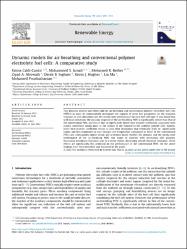| dc.contributor.author | Calili-Cankir, Fatma | |
| dc.contributor.author | Ismail, Mohammed S. | |
| dc.contributor.author | Berber, Mohamed R. | |
| dc.contributor.author | Alrowaili, Ziyad A. | |
| dc.contributor.author | Ingham, Derek B. | |
| dc.contributor.author | Hughes, Kevin J. | |
| dc.contributor.author | Ma, Lin | |
| dc.contributor.author | Pourkashanian, Mohamed | |
| dc.date.accessioned | 2022-11-21T08:14:04Z | |
| dc.date.available | 2022-11-21T08:14:04Z | |
| dc.date.issued | 2022 | en_US |
| dc.identifier.citation | Calili-Cankir, F., Ismail, M.S., Berber, M.R., Alrowaili, Z.A., Ingham, D.B., Hughes, K.J., Ma, L., Pourkashanian, M. (2022). Dynamic models for air-breathing and conventional polymer electrolyte fuel cells: A comparative study. Renewable Energy, 195, pp. 1001-1014.
https://doi.org/10.1016/j.renene.2022.06.092 | en_US |
| dc.identifier.uri | https://doi.org/10.1016/j.renene.2022.06.092 | |
| dc.identifier.uri | https://hdl.handle.net/20.500.12508/2291 | |
| dc.description.abstract | Two dynamic models have been built for air-breathing and conventional polymer electrolyte fuel cells (PEFCs) in order to comparatively investigate the impacts of some key parameters on the transient response to load alterations and the steady-state performance for each fuel cell type. It was found that with load alterations, the dynamic response of the air-breathing PEFC is significantly slower than that of the conventional PEFC and this is due to significantly slower heat transfer coefficients associated with natural convection taking place at the surface of the exposed-to-the ambient cathode GDL. Namely, lower heat transfer coefficient results in poor heat dissipation that eventually leads to: significantly higher and less-responsive-to-load changes cell temperature (compared to those of the conventional PEFC) and subsequently higher ohmic and activation losses. Further, the dynamic and the steady-state performance of the air-breathing PEFC was found to increase with decreasing GDL porosity, decreasing membrane thickness and, to a lesser extent, decreasing overall electrical resistance. These effects are significantly less profound on the performance of the conventional PEFC. All the above findings have been described and discussed in the paper. | en_US |
| dc.language.iso | eng | en_US |
| dc.publisher | Elsevier | en_US |
| dc.relation.isversionof | 10.1016/j.renene.2022.06.092 | en_US |
| dc.rights | info:eu-repo/semantics/openAccess | en_US |
| dc.subject | Air-breathing PEFCs | en_US |
| dc.subject | Conventional PEFCs | en_US |
| dc.subject | Dynamic model | en_US |
| dc.subject | Load alterations | en_US |
| dc.subject | Transient response | en_US |
| dc.subject.classification | Proton Exchange Membrane Fuel Cell (PEMFC) | |
| dc.subject.classification | Diffusion in Gases | |
| dc.subject.classification | Electrode | |
| dc.subject.classification | Science & Technology - Other Topics | |
| dc.subject.classification | Energy & Fuels | |
| dc.subject.classification | Chemistry - Electrochemistry - Proton Conductivity | |
| dc.subject.other | Flow-channel | |
| dc.subject.other | Performance | |
| dc.subject.other | Cathode | |
| dc.subject.other | Hydrogen | |
| dc.subject.other | Configurations | |
| dc.subject.other | Planar | |
| dc.subject.other | Stack | |
| dc.subject.other | Dynamic models | |
| dc.subject.other | Heat transfer coefficients | |
| dc.subject.other | Polyelectrolytes | |
| dc.subject.other | Proton exchange membrane fuel cells (PEMFC) | |
| dc.subject.other | Solid electrolytes | |
| dc.subject.other | Comparative study | |
| dc.subject.other | Convection | |
| dc.subject.other | Dynamic response | |
| dc.subject.other | Electrolyte | |
| dc.subject.other | Energy dissipation | |
| dc.subject.other | Fuel cell | |
| dc.subject.other | Heat transfer | |
| dc.subject.other | Numerical model | |
| dc.subject.other | Polymer | |
| dc.subject.other | Transient analysis | |
| dc.title | Dynamic models for air-breathing and conventional polymer electrolyte fuel cells: A comparative study | en_US |
| dc.type | article | en_US |
| dc.relation.journal | Renewable Energy | en_US |
| dc.contributor.department | Mühendislik ve Doğa Bilimleri Fakültesi -- Enerji Sistemleri Mühendisliği Bölümü | en_US |
| dc.identifier.volume | 195 | en_US |
| dc.relation.publicationcategory | Makale - Uluslararası Hakemli Dergi - Kurum Öğretim Elemanı | en_US |
| dc.contributor.isteauthor | Calili-Cankir, Fatma | |
| dc.relation.index | Web of Science - Scopus | en_US |
| dc.relation.index | Web of Science Core Collection - Science Citation Index Expanded | |
















